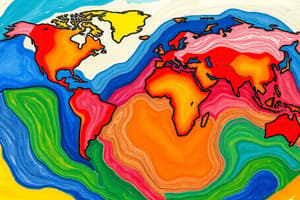Podcast
Questions and Answers
What primarily causes oceanic crust to be subducted under continental crust?
What primarily causes oceanic crust to be subducted under continental crust?
- Oceanic crust is denser than continental crust. (correct)
- Oceanic crust is more buoyant than continental crust.
- Continental crust is typically thicker than oceanic crust.
- Oceanic crust is older than continental crust.
Which geological feature is formed at a convergent boundary where two continental plates collide?
Which geological feature is formed at a convergent boundary where two continental plates collide?
- Volcanic island arcs
- Mid-ocean ridges
- Oceanic trenches
- Mountain ranges (correct)
What leads to the formation of island arcs?
What leads to the formation of island arcs?
- Continental drift
- Subduction of older oceanic plates under newer oceanic plates (correct)
- The collision of two continental plates
- Older continental plates sinking
What geological phenomenon is primarily responsible for the creation of trenches?
What geological phenomenon is primarily responsible for the creation of trenches?
Why do some volcanic eruptions become explosive?
Why do some volcanic eruptions become explosive?
What is the reason for the Himalayas, particularly Mount Everest, growing nearly an inch each year?
What is the reason for the Himalayas, particularly Mount Everest, growing nearly an inch each year?
Which of the following is a result of large underwater earthquakes?
Which of the following is a result of large underwater earthquakes?
Which event in December 2004 resulted in the death of more than 200,000 people in 11 countries?
Which event in December 2004 resulted in the death of more than 200,000 people in 11 countries?
Study Notes
Structure of the Earth
- Earth's structure: crust, mantle, outer core, inner core
Historical Context of Earth's Layers
- Seismic waves helped scientists understand Earth's interior
- Evidence for continental drift:
- Coastlines of continents fitting together
- Similar fossils on different continents
- Matching mountain ranges
- Pangea existed 250 million years ago
Evidence Supporting Plate Tectonics
- Seafloor Spreading: New oceanic crust is created at mid-ocean ridges and moves away, spreading the seafloor
- Magnetic Stripes: Rock on the ocean floor has alternating magnetic polarities, indicating reversals in Earth's magnetic field
- Fossil Distribution: Similar fossils found on continents now separated by oceans
- Hotspots: Volcanic activity independent of plate boundaries, creating chains of islands like Hawaii
Modern Understanding of Plate Tectonics
- Earth's lithosphere is broken into plates that move on the asthenosphere
- Plate movement caused by convection currents in the mantle
- Plate interactions cause earthquakes, volcanoes, and mountain formation
Overview of Crust Types
- Continental crust: thicker, less dense, older (over 4 billion years)
- Oceanic crust: thinner, denser, younger (up to 200 million years)
Tectonic Plate Boundaries
- Convergent boundaries: plates collide
- Oceanic-Oceanic: older oceanic plate subducts under newer oceanic plate creating island arcs
- Oceanic-Continental: Oceanic plate subducts under continental plate leading to trenches and volcanoes on the continent
- Continental-Continental: Two continental plates collide and buckle to form mountains
- Divergent boundaries: plates move apart
- Mid-ocean ridges: New oceanic crust is formed
- Rift valleys: Continental crust splits, creating valleys
- Transform boundaries: plates slide past each other
- Earthquakes: Frequent and significant earthquakes occur where plates are sliding past each other
Convergent Boundaries
- Subduction zones: where one plate slides under another
- Leading to: island arcs, trenches, and volcanoes
- Examples of volcanic arcs: Mariana Islands and Aleutian Islands
Mountain Formation
- Mountain ranges formed by the collision of two continental plates
- The Himalayas: Mt. Everest is growing nearly an inch each year as the plates continue to collide
Geological Phenomena Associated with Plate Movement
- Volcanic Activity:
- Effusive eruptions: Slow, steady flow of lava
- Explosive eruptions: Violent, rapid release of magma and ash
- Factors influencing eruption style: Pressure, Rate of degassing, and Viscosity of magma
- Earthquakes and Tsunamis:
- Earthquakes occur at plate boundaries, causing tremors and displacement of the Earth's crust
- Tsunamis are caused by large underwater earthquakes, leading to massive waves that can cause widespread devastation
- Example: 2004 Asian Tsunami killed over 200,000 people in 11 countries across the Indian Ocean region.
Studying That Suits You
Use AI to generate personalized quizzes and flashcards to suit your learning preferences.
Related Documents
Description
Explore the intricate structure of the Earth, including its crust, mantle, and core. Delve into the historical context of Earth's layers, the evidence supporting plate tectonics, and modern understandings of lithospheric movement. This quiz covers essential concepts such as continental drift and seafloor spreading.




